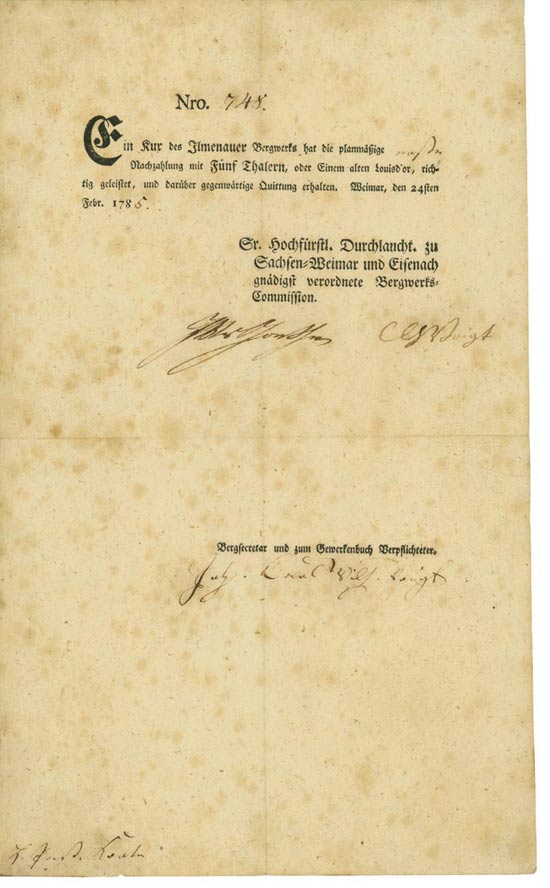Ingelsberg 17 b
D- 85604 Zorneding
Deutschland / Germany
Tel.: +49 (0)8106 - 2461-86
Fax: +49 (0)8106 - 2461-88
E-Mail: auktion@hwph.de
HWPH Historisches Wertpapierhaus AG –
Your expert for historical stocks, bonds
and financial history
|
||||
Item number |
29 | |||
Name |
Ilmenauer Kupfer- und Silberbergwerk | |||
Location(s) |
Weimar | |||
Country |
Deutschland | |||
Region |
Deutschland | |||
Description |
Weimar, 24.02.1785, Quittungsschein über eine planmäßige Nachzahlung in Höhe von 5 Thalern, #748, 32,6 x 19,7 cm, schwarz, weiß, Erhaltung VF, Original-Signaturen Johann Wolfgang von Goethe, Johann Carl Wilhelm Voigt und Christian Gottlieb Voigt. Rarität! Die Kuxe wurden bei Zeichnung nur zu 50 Prozent, also mit 10 Thalern eingezahlt. Die restlichen beiden Raten zu je 5 Thaler wurden in den Jahren 1785 und 1786 fällig. Für diese Nachzahlung erhielten die Gewerken die vorliegende Quittung, die das gleiche Format wie der Kux hat. Nicht zu verwechseln mit den Zubußquittungen, die deutlich häufiger sind! | |||
Description (English) |
Weimar, 24 February 1785, Share call receipt for 5 thalers, #748, 32.6 x 19.7 cm, black, white, original signatures of Johann Wolfgang von Goethe, Johann Carl Wilhelm Voigt and Christian Gottlieb Voigt. A rarity! The company’s Kuxe (mining shares) were 50 per cent paid up on application, which is 10 thalers. The two remaining instalments of 5 thalers were due in 1785 and 1786. The subscribers were given receipts for these subsequent payments, in a format rather similar to the Kuxe. Not to be confused with the Zubußquittungen (assessments on shareholders for losses) which are considerably more common. | |||
Condition |
VF | |||
 |
||||
History (German) |
Johann Wolfgang von Goethe wurde am 28.08.1749 in Frankfurt am Main geboren. Er ist als Dichter, Theaterleiter, Naturwissenschaftler, Kunsttheoretiker und Staatsmann der wichtigste Vertreter der Weimarer Klassik. Sein Werk umfasst vor allem Gedichte, Dramen und Prosa-Literatur, allerdings auch naturwissenschaftliche Abhandlungen. Er gilt als der herausragendste deutsche Dichter und ist eine herausragende Persönlichkeit der Weltliteratur. Goethes Familie lebte in Frankfurt am Main. Von 1765 bis 1768 studierte Goethe in Leipzig Jura. Doch mehr als die Jura-Vorlesungen zogen ihn Poetik-Vorlesungen von Christian Fürchtegott Gellert an. Zudem nahm er Zeichenunterricht bei Adam Friedrich Oeser. Später vollende er sein Jura-Studium im Straßburg, ohne dass ihn der Beruf des Rechtsanwalts anschließend Spaß brachte. Er widmet sich lieber seinen Gedichten. In dieser Zeit entstand bereits die Urfassung des Goetz von Berlchingen. Ende 1775 folgte Goethe einer Einladung von Karl-August von Sachsen-Weimar-Eisenach nach Weimar. Nach einer Italienreise kehrte Goethe nach Weimar zurück und gewann Friedrich Schiller zur Mitarbeit an seiner Zeitschrift Die Horen. Hieraus entwickelte sich eine Freundschaft. 1811 erscheint der erste Teil seiner Autobiographie Dichtung und Wahrheit. 1830, zwei Jahre vor seinem Tod am 22.03.1832, erscheint der vierte Teil seiner Autobiographie. Goethe wurde neben Friedrich Schiller in der Weimarer Fürstengruft beigesetzt. | |||
History (English) |
Johann Wolfgang von Goethe was born 28 August 1749 in Frankfurt on Main. Being a poet, director of a theatre, scientist, art historian and statesman, he is the most important representative of Weimar Classicism. His works comprised in particular poems, dramas and pink-literature, and also scientific papers. He is considered the most outstanding German poet and is an important personality in world literature. Goethe’s family lived in Frankfurt on Main. From 1765 until 1768 Goethe studied law in Leipzig. But more than the law lectures he was lured by the poetry lectures of Christian Fürchtegott Gellert. In addition he had drawing lessons with Adam Friedrich Oeser. Later he finished his law studies in Strasbourg, without becoming a passionate lawyer afterwards. He preferred to spend his time on poetry. During this time he created the original version of “Goetz von Berlchingen”. At the end of the year 1775 Goethe accepted an invitation from Duke Karl-August of Sachsen-Weimar-Eisenach and came to Weimar. After a visit to Italy he returned to Weimar where he lured Friedrich Schiller to work with him on his journal „Die Horen”. This co-operation turned into friendship. In 1811 the first part of his autobiography „Dichtung und Wahrheit“ (Poetry and Truth) was released. In 1830, two years before he died on 22 March 1832, the fourth part of his autobiography came out. Goethe was entombed in the Weimar Princes’ Tomb alongside Friedrich Schiller. | |||
Please have a look at our highlight items: |
||||













